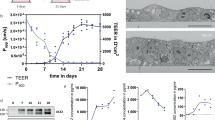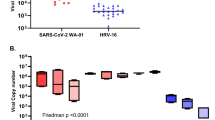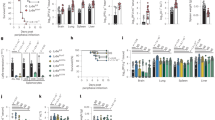Abstract
Of the many biologically isolated adeno-associated virus (AAV) serotypes, AAV1 and AAV6 share the highest degree of sequence homology, with only six different capsid residues. We compared the transduction efficiencies of rAAV1 and rAAV6 in primary polarized human airway epithelia and found significant differences in their abilities to transduce epithelia from the apical and basolateral membranes. rAAV1 transduction was ∼10-fold higher than rAAV6 following apical infection, whereas rAAV6 transduction was ∼10-fold higher than rAAV1 following basolateral infection. Furthermore, rAAV6 demonstrated significant polarity of transduction (100-fold; basolateral » apical), whereas rAAV1 transduced from both membranes with equal efficiency. To evaluate capsid residues responsible for the observed serotype differences, we mutated the six divergent amino acids either alone or in combination. Results from these studies demonstrated that capsid residues 418 and 531 most significantly controlled membrane polarity differences in transduction between serotypes, with the rAAV6-D418E/K531E mutant demonstrating decreased (∼10-fold) basolateral transduction and the rAAV1-E418D/E531K mutant demonstrating a transduction polarity identical to rAAV6-WT (wild type). However, none of the rAAV6 mutants obtained apical transduction efficiencies of rAAV1-WT, suggesting that all six divergent capsid residues in AAV1 act in concert to improve apical transduction of HAE.
This is a preview of subscription content, access via your institution
Access options
Subscribe to this journal
Receive 12 print issues and online access
$259.00 per year
only $21.58 per issue
Buy this article
- Purchase on Springer Link
- Instant access to full article PDF
Prices may be subject to local taxes which are calculated during checkout






Similar content being viewed by others
References
Blacklow NR . Adeno-associated viruses of human. In: Pattison JR (ed). Parvoviruses and Human Disease. CRC Press Boca Raton, 1988, pp 165–174.
Carter BJ . Adeno-associated virus and the development of adeno-associated virus vectors: a historical perspective. Mol Ther 2004; 10: 981–989.
Carter BJ . Adeno-associated virus vectors in clinical trials. Hum Gene Ther 2005; 16: 541–550.
Gao G, Vandenberghe LH, Wilson JM . New recombinant serotypes of AAV vectors. Curr Gene Ther 2005; 5: 285–297.
Wu Z, Asokan A, Samulski RJ . Adeno-associated virus serotypes: vector toolkit for human gene therapy. Mol Ther 2006; 14: 316–327.
Zincarelli C, Soltys S, Rengo G, Rabinowitz JE . Analysis of AAV serotypes 1–9 mediated gene expression and tropism in mice after systemic injection. Mol Ther 2008; 16: 1073–1080.
Schaffer DV, Maheshri N . Directed evolution of AAV mutants for enhanced gene delivery. Conf Proc IEEE Eng Med Biol Soc 2004; 5: 3520–3523.
Koerber JT, Jang JH, Schaffer DV . DNA shuffling of adeno-associated virus yields functionally diverse viral progeny. Mol Ther 2008; 16: 1703–1709.
Excoffon KJ, Koerber JT, Dickey DD, Murtha M, Keshavjee S, Kaspar BK et al. Directed evolution of adeno-associated virus to an infectious respiratory virus. Proc Natl Acad Sci USA 2009; 106: 3865–3870.
Boutin S, Monteilhet V, Veron P, Leborgne C, Benveniste O, Montus MF et al. Prevalence of serum IgG and neutralizing factors against adeno-associated virus (AAV) types 1, 2, 5, 6, 8, and 9 in the healthy population: implications for gene therapy using AAV vectors. Hum Gene Ther 2010; 21: 704–712.
Padron E, Bowman V, Kaludov N, Govindasamy L, Levy H, Nick P et al. Structure of adeno-associated virus type 4. J Virol 2005; 79: 5047–5058.
Li W, Zhang L, Johnson JS, Zhijian W, Grieger JC, Ping-Jie X et al. Generation of novel AAV variants by directed evolution for improved CFTR delivery to human ciliated airway epithelium. Mol Ther 2009; 17: 2067–2077.
Halbert CL, Allen JM, Miller AD . Adeno-associated virus type 6 (AAV6) vectors mediate efficient transduction of airway epithelial cells in mouse lungs compared to that of AAV2 vectors. J Virol 2001; 75: 6615–6624.
Wu Z, Asokan A, Grieger JC, Govindasamy L, Agbandje-McKenna M, Samulski RJ . Single amino acid changes can influence titer, heparin binding, and tissue tropism in different adeno-associated virus serotypes. J Virol 2006; 80: 11393–11397.
Wu Z, Miller E, Agbandje-McKenna M, Samulski RJ . Alpha2,3 and alpha2,6 N-linked sialic acids facilitate efficient binding and transduction by adeno-associated virus types 1 and 6. J Virol 2006; 80: 9093–9103.
Grimm D, Zhou S, Nakai H, Thomas CE, Storm TA, Fuess S et al. Preclinical in vivo evaluation of pseudotyped adeno-associated virus vectors for liver gene therapy. Blood 2003; 102: 2412–2419.
Grimm D, Kay MA, Kleinschmidt JA . Helper virus-free, optically controllable, and two-plasmid-based production of adeno-associated virus vectors of serotypes 1 to 6. Mol Ther 2003; 7: 839–850.
Flotte TR . Recent developments in recombinant AAV-mediated gene therapy for lung diseases. Curr Gene Ther 2005; 5: 361–366.
Aitken ML, Moss RB, Waltz DA, Dovey ME, Tonelli MR, McNamara SC et al. A phase I study of aerosolized administration of tgAAVCF to cystic fibrosis subjects with mild lung disease. Hum Gene Ther 2001; 12: 1907–1916.
Wagner JA, Nepomuceno IB, Messner AH, Moran ML, Batson EP, Dimiceli S et al. A phase II, double-blind, randomized, placebo-controlled clinical trial of tgAAVCF using maxillary sinus delivery in patients with cystic fibrosis with antrostomies. Hum Gene Ther 2002; 13: 1349–1359.
Moss RB, Milla C, Colombo J, Accurso F, Zeitlin PL, Clancy JP et al. Repeated aerosolized AAV-CFTR for treatment of cystic fibrosis: a randomized placebo-controlled phase 2B trial. Hum Gene Ther 2007; 18: 726–732.
Duan D, Yue Y, Yan Z, Yang J, Engelhardt JF . Endosomal processing limits gene transfer to polarized airway epithelia by adeno-associated virus. J Clin Invest 2000; 105: 1573–1587.
Yan Z, Lei-Butters DC, Liu X, Zhang Y, Zhang L, Luo M et al. Unique biologic properties of recombinant AAV1 transduction in polarized human airway epithelia. J Biol Chem 2006; 281: 29684–29692.
Yan Z, Zak R, Luxton GW, Ritchie TC, Bantel-Schaal U, Engelhardt JF . Ubiquitination of both adeno-associated virus type 2 and 5 capsid proteins affects the transduction efficiency of recombinant vectors. J Virol 2002; 76: 2043–2053.
Zhong L, Li B, Jayandharan G, Mah CS, Govindasamy L, Agbandje-McKenna M et al. Tyrosine-phosphorylation of AAV2 vectors and its consequences on viral intracellular trafficking and transgene expression. Virology 2008; 381: 194–202.
Zhong L, Li B, Mah CS, Govindasamy L, Agbandje-McKenna M, Cooper M et al. Next generation of adeno-associated virus 2 vectors: point mutations in tyrosines lead to high-efficiency transduction at lower doses. Proc Natl Acad Sci USA 2008; 105: 7827–7832.
Ding W, Zhang L, Yan Z, Engelhardt JF . Intracellular trafficking of adeno-associated viral vectors. Gene Therapy 2005; 12: 873–880.
Limberis MP, Vandenberghe LH, Zhang L, Pickles RJ, Wilson JM . Transduction efficiencies of novel AAV vectors in mouse airway epithelium in vivo and human ciliated airway epithelium in vitro. Mol Ther 2009; 17: 294–301.
Virella-Lowell I, Zusman B, Foust K, Loiler S, Conlon T, Song S et al. Enhancing rAAV vector expression in the lung. J Gene Med 2005; 7: 842–850.
Halbert CL, Madtes DK, Vaughan AE, Wang Z, Storb R, Tapscott SJ et al. Expression of human alpha1-antitrypsin in mice and dogs following AAV6 vector-mediated gene transfer to the lungs. Mol Ther 2010; 18: 1165–1172.
Flotte TR, Fischer AC, Goetzmann J, Mueller C, Cebotaru L, Yan Z et al. Dual reporter comparative indexing of rAAV pseudotyped vectors in chimpanzee airway. Mol Ther 2010; 18: 594–600.
Ding W, Zhang LN, Yeaman C, Engelhardt JF . rAAV2 traffics through both the late and the recycling endosomes in a dose-dependent fashion. Mol Ther 2006; 13: 671–682.
Agbandje-McKenna M, Kleinschmidt J . AAV capsid structure and cell interactions. Methods Mol Biol 2011; 807: 47–92.
Chapman MS, Agbandje-McKenna M . Atomic structure of viral particles. In: Kerr JR, Cotmore SF, Bloom ME, Linden RM, Parrish CR (eds). Parvoviruses. Edward Arnold, Ltd New York, NY, 2006, pp 107–123.
Ng R, Govindasamy L, Gurda BL, McKenna R, Kozyreva OG, Samulski RJ et al. Structural characterization of the dual glycan binding adeno-associated virus serotype 6. J Virol 2010; 84: 12945–12957.
Nam HJ, Gurda BL, McKenna R, Potter M, Byrne B, Salganik M et al. Structural studies of adeno-associated virus serotype 8 capsid transitions associated with endosomal trafficking. J Virol 2011; 85: 11791–11799.
Lerch TF, Xie Q, Chapman MS . The structure of adeno-associated virus serotype 3B (AAV-3B): insights into receptor binding and immune evasion. Virology 2010; 403: 26–36.
Liu X, Luo M, Guo C, Yan Z, Wang Y, Engelhardt JF . Comparative biology of rAAV transduction in ferret, pig and human airway epithelia. Gene Therapy 2007; 14: 1543–1548.
Liu X, Luo M, Trygg C, Yan Z, Lei-Butters DC, Smith CI et al. Biological differences in rAAV transduction of airway epithelia in humans and in old world non-human primates. Mol Ther 2007; 15: 2114–2123.
Liu X, Yan Z, Luo M, Engelhardt JF . Species-specific differences in mouse and human airway epithelial biology of recombinant adeno-associated virus transduction. Am J Respir Cell Mol Biol 2006; 34: 56–64.
Li W, Zhang L, Wu Z, Pickles RJ, Samulski RJ . AAV-6 mediated efficient transduction of mouse lower airways. Virology 2011; 417: 327–333.
Karp PH, Moninger TO, Weber SP, Nesselhauf TS, Launspach JL, Zabner J et al. An in vitro model of differentiated human airway epithelia. Methods for establishing primary cultures. Methods Mol Biol 2002; 188: 115–137.
Acknowledgements
This work was supported by NIH grants HL108902 (to JFE), the Roy J Carver Chair in Molecular Medicine (to JFE), and the University of Iowa Center for Gene Therapy (DK54759).
Author information
Authors and Affiliations
Corresponding author
Ethics declarations
Competing interests
The authors declare no conflict of interest.
Rights and permissions
About this article
Cite this article
Yan, Z., Lei-Butters, D., Keiser, N. et al. Distinct transduction difference between adeno-associated virus type 1 and type 6 vectors in human polarized airway epithelia. Gene Ther 20, 328–337 (2013). https://doi.org/10.1038/gt.2012.46
Received:
Revised:
Accepted:
Published:
Issue Date:
DOI: https://doi.org/10.1038/gt.2012.46
Keywords
This article is cited by
-
Inhalable delivery of AAV-based MRP4/ABCC4 silencing RNA prevents monocrotaline-induced pulmonary hypertension
Molecular Therapy - Methods & Clinical Development (2015)
-
Prolonged expression of an anti-HIV-1 gp120 minibody to the female rhesus macaque lower genital tract by AAV gene transfer
Gene Therapy (2014)
-
A Novel Chimeric Adenoassociated Virus 2/Human Bocavirus 1 Parvovirus Vector Efficiently Transduces Human Airway Epithelia
Molecular Therapy (2013)



